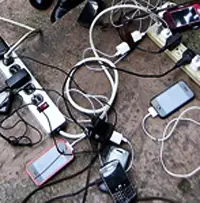Good Samaritans who have electricity are offering “charging stations” to help the millions who are without power after Hurricane Sandy, including using extension cords and power strips to create temporary charging stations. Avoid safety hazards and practice safety when using these temporary charging stations with advice from Safe Electricity.
 |
In the wake of Superstorm Sandy, 8.5 million people have been without electricity. Generous people who do have power are offering “charging stations” to those without. Businesses and individuals are using extension cords and power strips to create temporary charging stations—some outdoors.
Safe Electricity urges those hosting and using indoor and outdoor charging stations to understand and avoid electrical dangers.
“It is encouraging to see Good Samaritans helping those without power,” says Molly Hall, executive director of the Energy Education Council, provider of the Safe Electricity program. “These temporary charging stations are okay for short-term use and are very helpful in this extreme situation. However, people should take safety precautions.”
Offering a safe charging station is fairly simple.
Safe Electricity has the following tips for those hosting and using charging stations in areas with power outages:
|
Those who host a charging station are also advised to have a fire extinguisher that is equipped to put out electrical fires.
For more information on safety following a major storm, visit SafeElectricity.org. The site provides comprehensive storm recovery information and resources on issues like prolonged outages, flooding (indoors and outside), downed power lines, and generator safety.
The Energy Education Council joins with millions nationally in thoughts and actions for a safe and swift recovery in the wake of Superstorm Sandy.





















